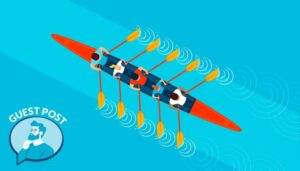Episode 4 in the Developing with AI Series for Faros AI
In this guest series, we’ve had the opportunity to introduce the challenges of measuring developer productivity, to uncover what that productivity delivers for the organization. We then explored how software development safety and velocity don’t need to be at odds or create undue risk.
Still, in modern development and deployment environments, it seems like human oversight alone will never be able to get teams of developers ahead of the rate of change.
To reach our destination at high velocity, all hands on deck should not only row faster but pull in the same direction—all while aligning their efforts with a regular cadence.
The practice of AI-augmented DevOps can optimize the pace of software delivery, by measuring work outputs and correlating signals with the intentions and goals of developers and teams.
A history of misaligned incentives and goals
Remember 10–15 years ago when pundits were promoting the concept of “bi-modal IT”—in which software delivery responsibilities would be segregated into two software delivery groups working at different paces?
-
One cohort in ‘fast’ mode, working in agile iterations, using the latest tools to build innovative functionality and release high-value customer-facing applications (AKA, the ‘cool kids’), and;
-
Everyone else in ‘slow’ mode, working to support and patch legacy apps and systems of record, which need to be slowly and carefully updated and monitored because they are too critical to fail (AKA ‘the grunts’).
Such pace layering represented the reality on the ground for many large enterprises. There would be one ‘Innovation Team’ tasked with prototyping new functionality and pushing the interface edge—totally disconnected from everyone else struggling with waterfall development dependencies, DBA requests, draconian change controls, and quarterly or annual release windows.
As analysts we relentlessly mocked bi-modal IT on several occasions. So let’s not allow the advent of AI-based development tooling create another such pace separation and throw off the cadence of our organization.
Software 2.0: Developing with AI
In this prescient 2017 article, Andrej Karpathy categorizes the whole of software development as we knew it—human developers writing code without AI assistance—as Software 1.0.
Thus, Software 2.0 would represent the next kind of development, one where much of the work of building software is handled by intricate AI models providing coding assistance and integration help, while human “developers” aren’t coding so much anymore. Instead, the ‘2.0 developer’ identifies desirable behaviors for the system, by curating and tagging the massive machine learning datasets needed to train the AI.
Weighting parameters for AI models, instead of coding application logic
Read the whole blog on the Faros AI site here: https://www.faros.ai/blog/achieving-an-ideal-tempo-with-ai-augmented-devops




